
Today the SP400 ETF (IJH) generated a new IT Trend Model "Neutral" Signal and yesterday, SP600 ETF (IJR) triggered the same. These signals are generated when the 20-EMA crosses below the 50-EMA while the 50-EMA is above the 200-EMA. Had these crossovers occurred below the 200-EMA, they would have been SELL signals.
Both charts show important support is being tested at the May-July lows. Given the very negative RSIs and the PMOs traveling lower below the zero line, it isn't likely that these levels will hold.
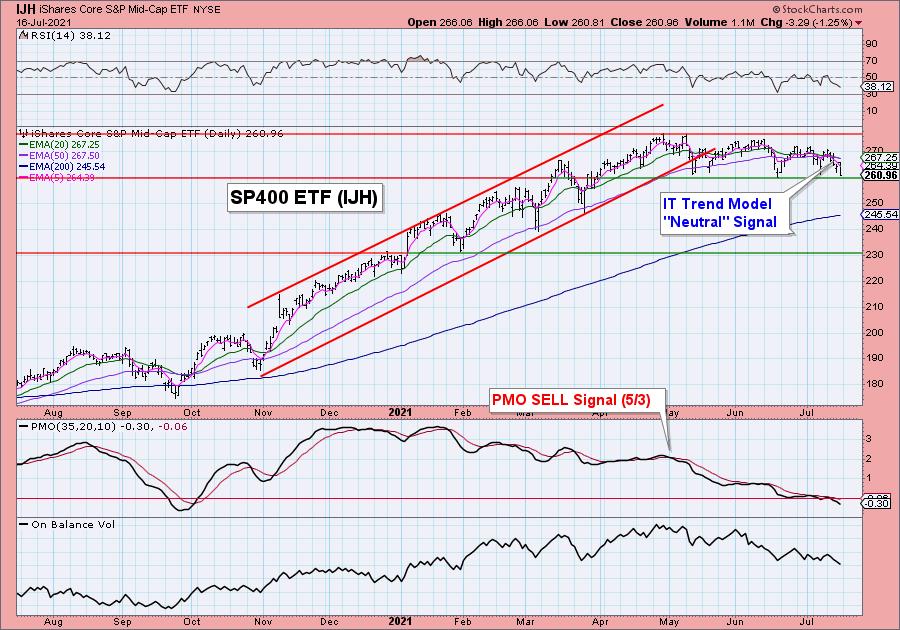
Be sure and read today's free article at this link where Carl covers participation numbers on both of these indexes. Spoiler alert: They are bearish.
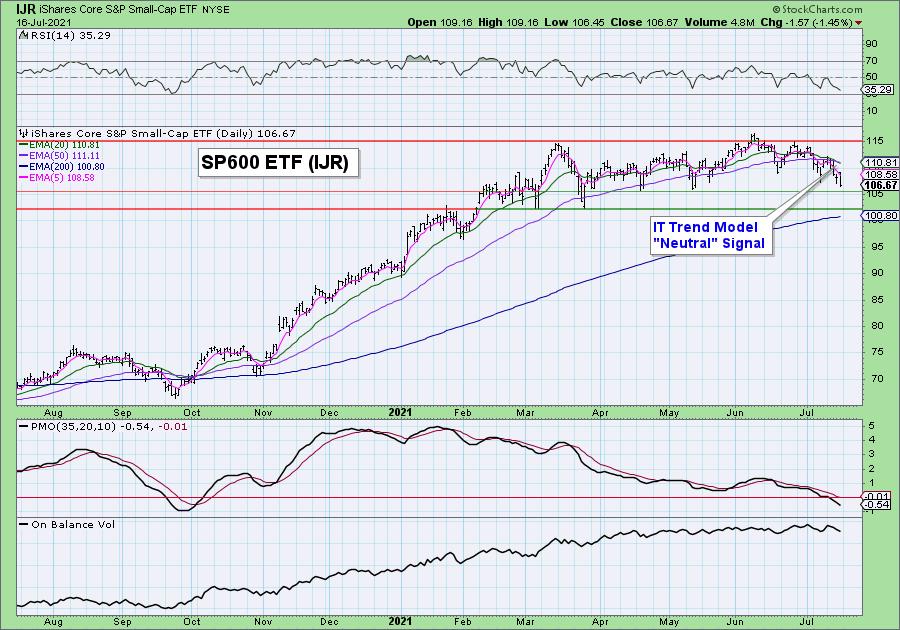
The DecisionPoint Alert Weekly Wrap presents an end-of-week assessment of the trend and condition of the Stock Market, the U.S. Dollar, Gold, Crude Oil, and Bonds. The DecisionPoint Alert daily report (Monday through Thursday) is abbreviated and gives updates on the Weekly Wrap assessments.
Watch the latest episode of DecisionPoint on StockCharts TV's YouTube channel here!
MAJOR MARKET INDEXES
For Friday:
For the week: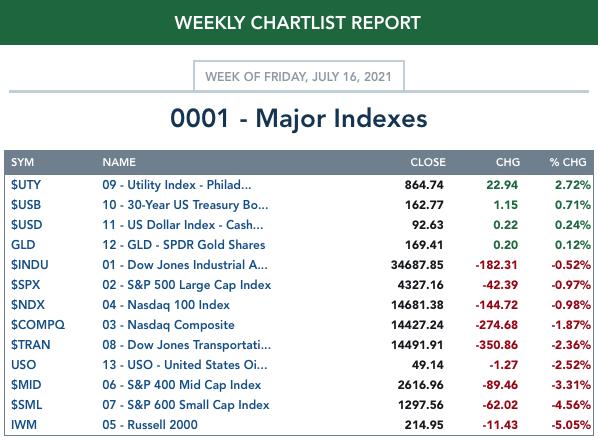
SECTORS
Each S&P 500 Index component stock is assigned to one, and only one, of 11 major sectors. This is a snapshot of the Intermediate-Term (Silver Cross) and Long-Term (Golden Cross) Trend Model signal status for those sectors.
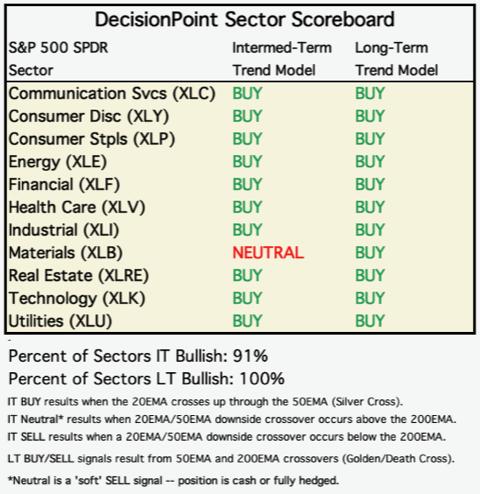
For Today: 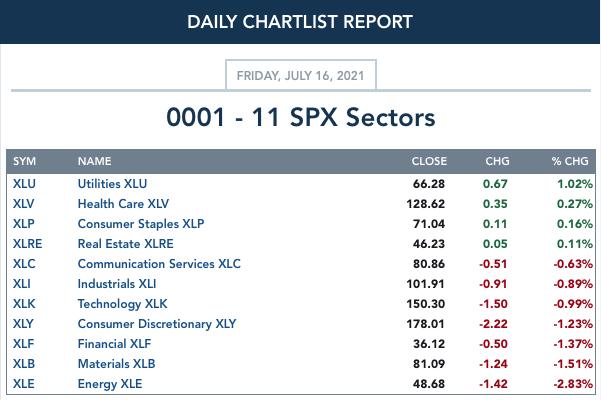
For the Week: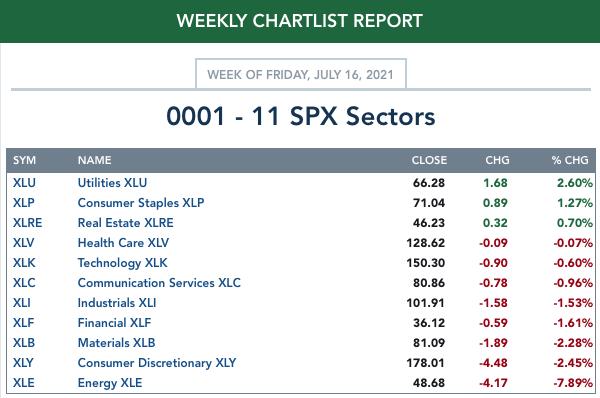
RRG® Chart: Daily version with 10-day "tail".
No sectors are Leading, but improvement can be seen for XLU, XLP and XLRE. Notice that this week, Technology (XLK), Discretionary (XLY) and Healthcare (XLV) all left the Leading category this week. There is a clear rotation into defensive areas of the market.
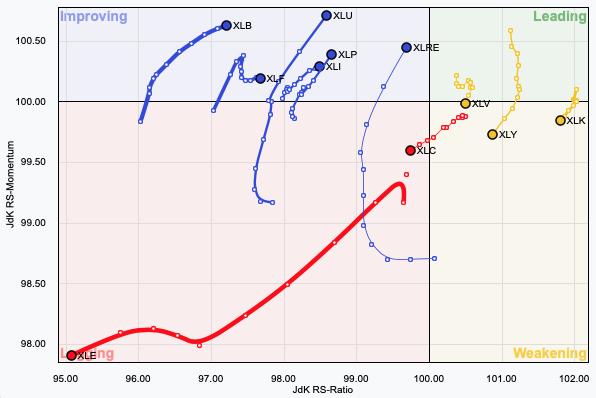
CLICK HERE for an animated version of the RRG chart.
CLICK HERE for Carl's annotated Sector charts.
THE MARKET (S&P 500)
IT Trend Model: BUY as of 5/8/2020
LT Trend Model: BUY as of 6/8/2020
SPY Daily Chart: As expected, volatility remained low during this options expiration week, as the range for SPY was a little less than 1.7%. The net change for the week was about -1.0%, nevertheless, one of the business shows characterized it as "A Rough Week for Stocks." How soon they forget. At this point, price is holding above the 20-EMA, but with a nearing PMO crossover SELL signal and quickly declining RSI, it may not be able to hold even the 50-EMA.
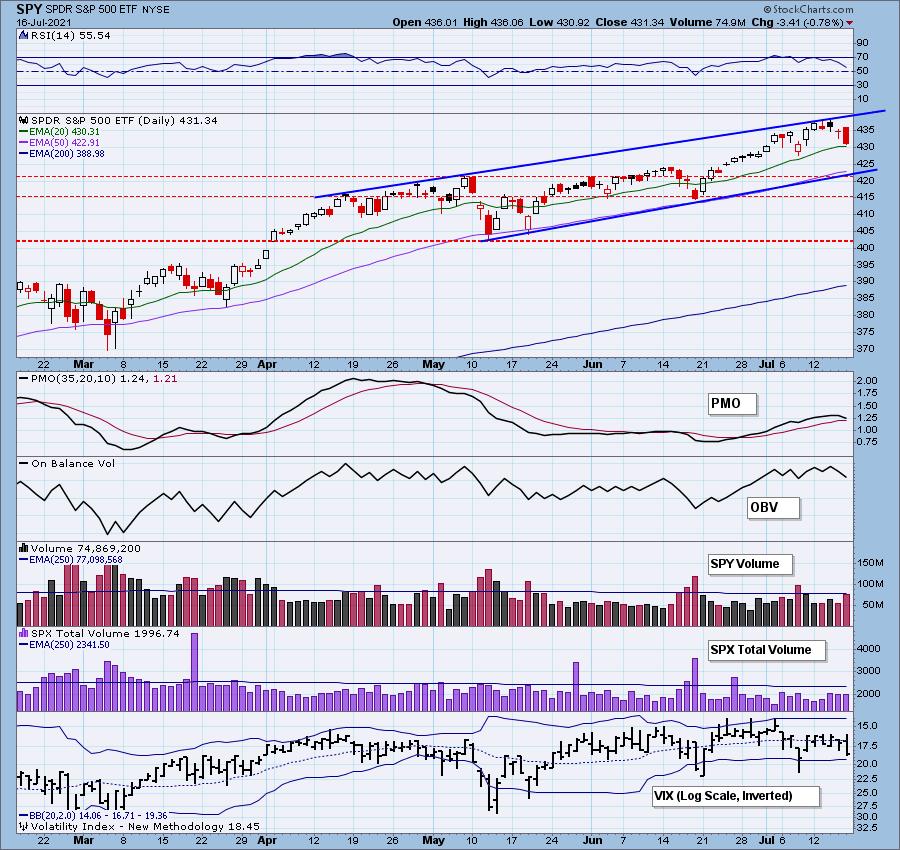
The bearish rising wedge that is apparent on the 5-month candlestick chart above can be more clearly seen on the one-year chart. While price remains in a rising trend channel, it continues to decline long before reaching the top of the channel. This suggests the intermediate-term rising bottoms trendline is in jeopardy.
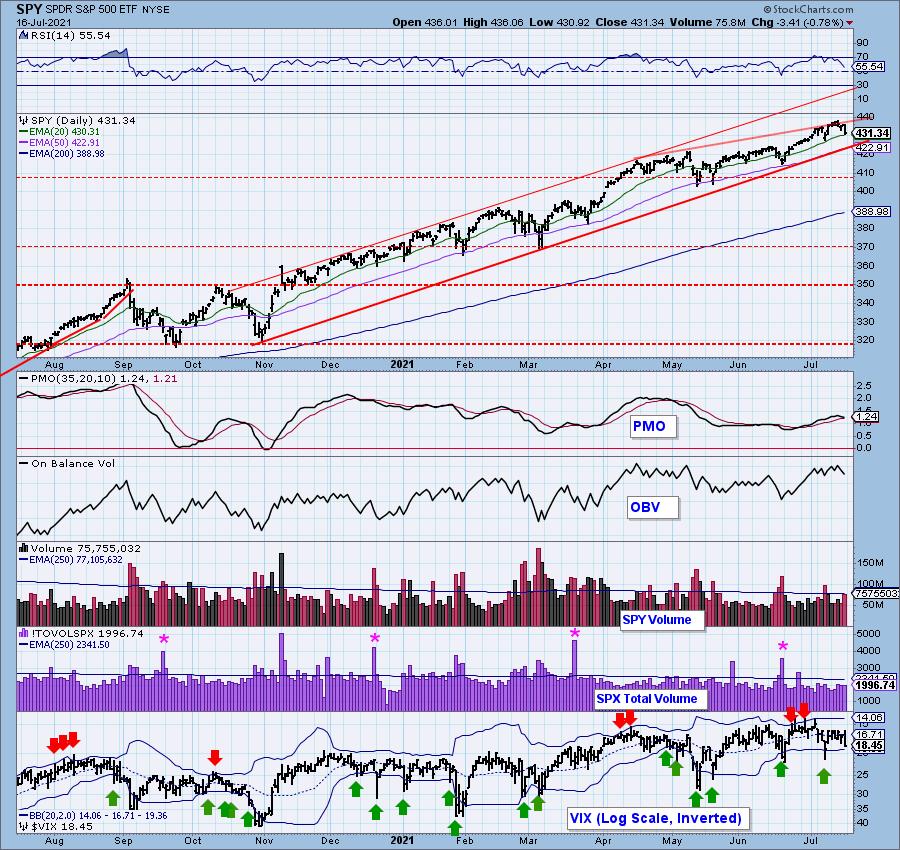
SPY Weekly Chart: We also have a very large long-term rising wedge on the weekly chart. The weekly PMO has topped below its signal line which is especially bearish and the RSI is overbought.
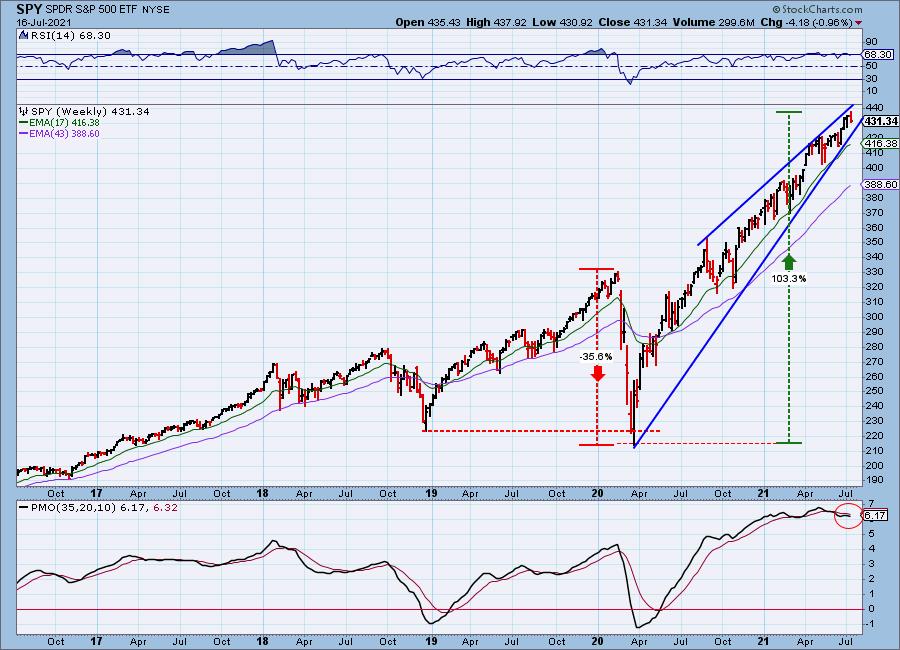
PARTICIPATION: The following chart uses different methodologies for objectively showing the depth and trend of participation for intermediate- and long-term time frames.
- The Silver Cross Index (SCI) shows the percentage of SPX stocks on IT Trend Model BUY signals (20-EMA > 50-EMA).
- The Golden Cross Index (GCI) shows the percentage of SPX stocks on LT Trend Model BUY signals (50-EMA > 200-EMA).
- The Bullish Percent Index (BPI) shows the percentage of SPX stocks on Point & Figure BUY signals.
(Excerpt from Carl's article on participation for not only SPY, but also for the SP400 and SP600)
"In spite of the market making new, all-time highs this week, participation continued to deteriorate. The Silver Cross Index for the S&P 500 has dropped to 60%, meaning that 60% of SPX stocks have the 20EMA above the 50EMA. Obviously, the largest component stocks are holding the index aloft. This is entirely possible because there are some giant stocks in the index; however, 60% is really starting to push the envelope. To make matters worse, only 50% of SPX stocks are above their 50EMA, meaning that there is the potential for an additional 10% of stocks to lose their Silver Cross status, which would leave only 50% of stocks supporting the index."
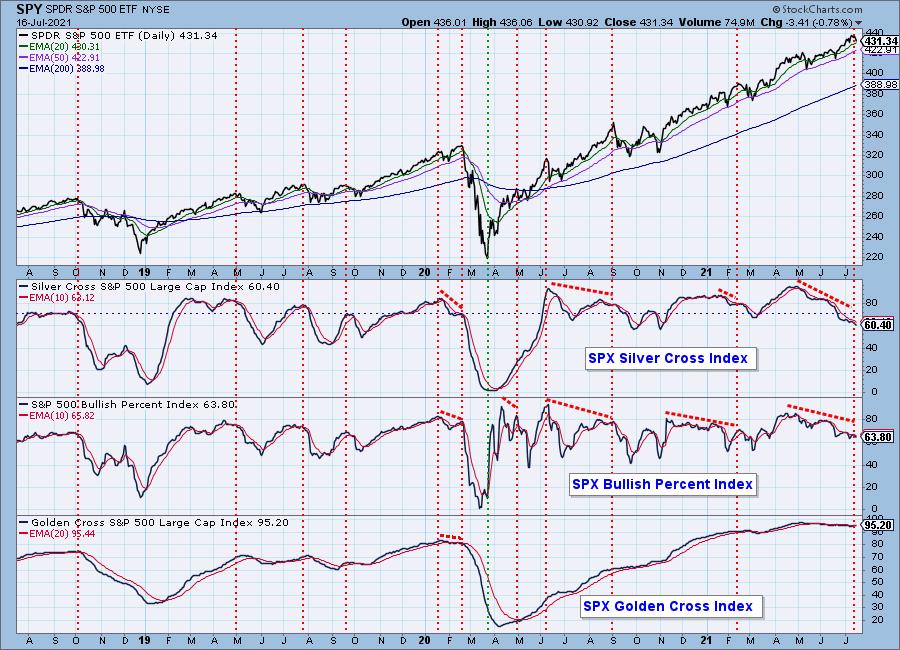
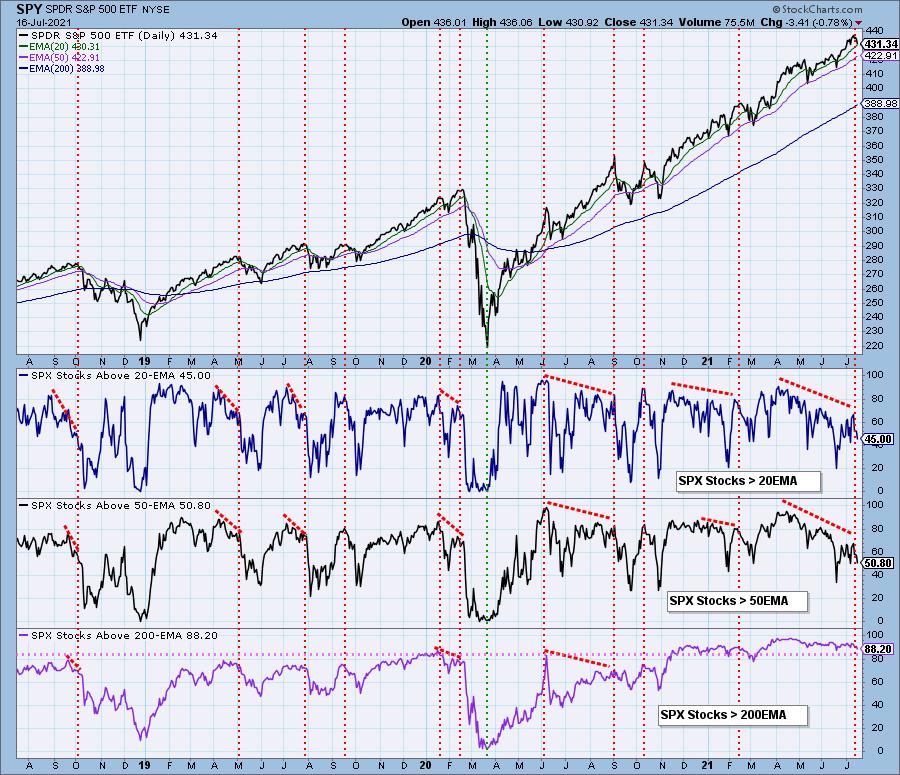
Climax Analysis: Readings on the climax chart don't show any "outside" climactic readings on Net A-D, but the Volume ratios are telling us today was a downside exhaustion climax. The VIX closed on its high today, but that didn't puncture the lower Bollinger Band on the inverted scale. So while we could be looking at a selling exhaustion, some of the readings suggest there could be more downside to digest.
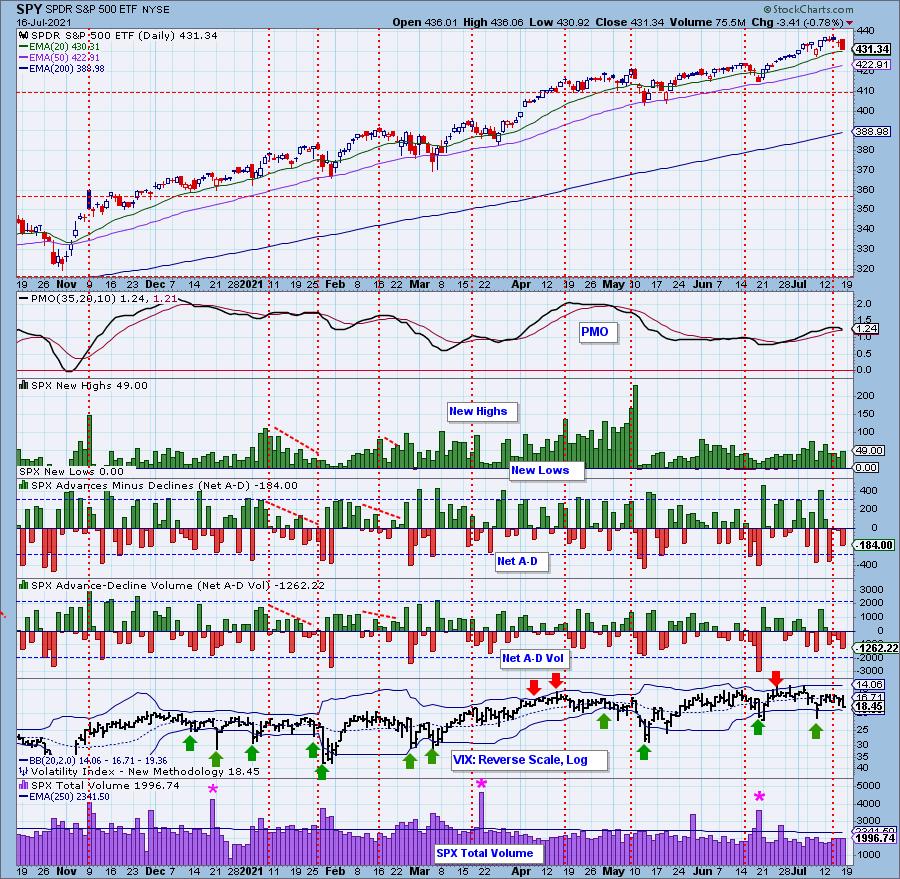
NYSE Up/Down and Down/Up volume ratios are also climax detectors. The 9:1 ratio suggested by the late Dr. Martin Zweig in his book, Winning on Wall Street, is especially significant, but we primarily look for spikes outside the normal range to clarify a particular event. We have an NYSE and S&P 500 version of the ratios, and normally they will only be published when there is a notable reading.
As stated above, even though we didn't see climactic Net A-D readings, the Down/Up Volume Ratios suggest today was a downside exhaustion climax. Why an exhaustion? Because the previous short-term trend was down.
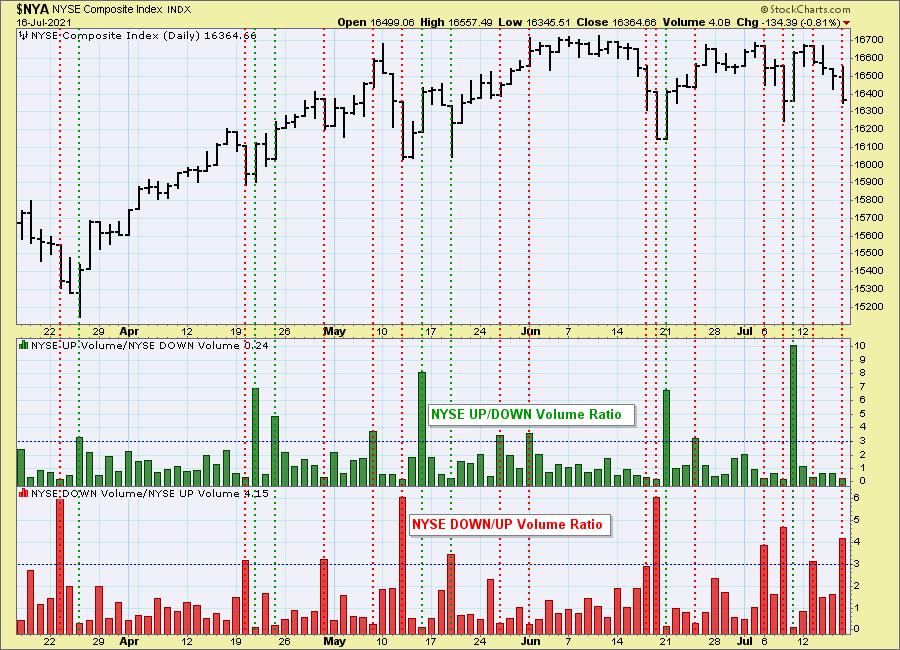
The S&P 500 version can get different results than the NYSE version because: (a) there are only 500 stocks versus a few thousand; and (b) those 500 stocks are all large-cap stocks that tend to move with more uniformity.

Short-Term Market Indicators: The short-term market trend is DOWN and the condition is SOMEWHAT OVERSOLD.
While Net A-D numbers were not climactic, the STOs popped lower, likely confirming today's selling exhaustion. Currently less than one-third of the SPX have rising momentum. This will not fuel a sustained rally, so don't count on the selling exhaustion to spur a new ride up to all-time highs.
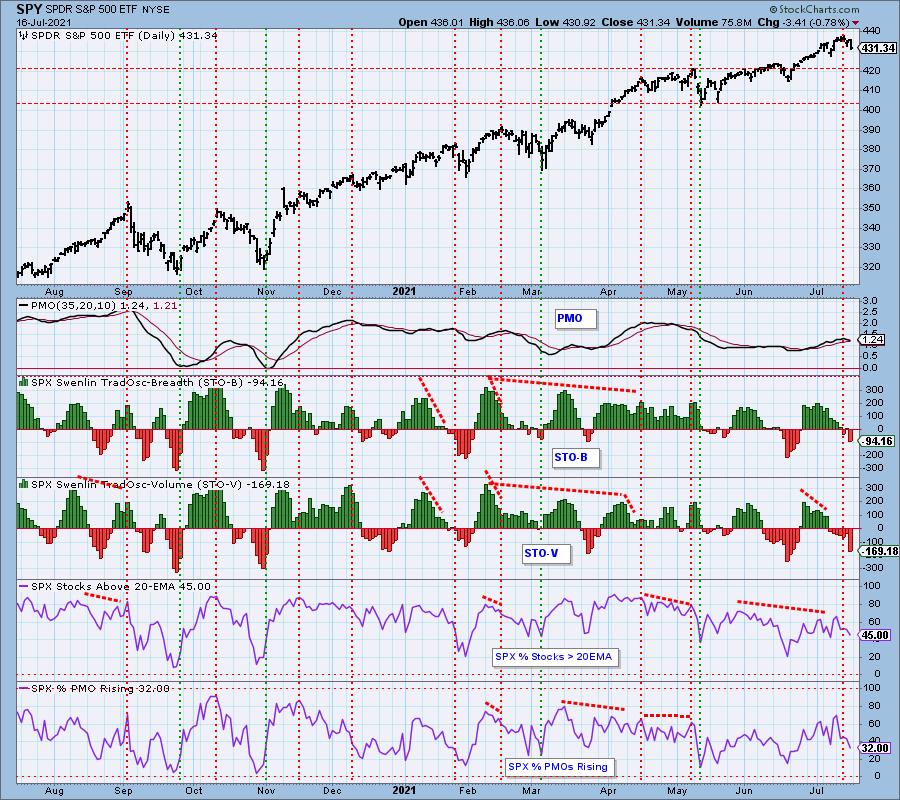
Intermediate-Term Market Indicators: The intermediate-term market trend is UP and the condition is NEUTRAL. The market bias is NEUTRAL.
IT indicators continue lower and are far from being considered oversold. Less than half of the SPX have PMO BUY signals. Knowing that only 32% have rising PMOs, that percentage will be damaged further.
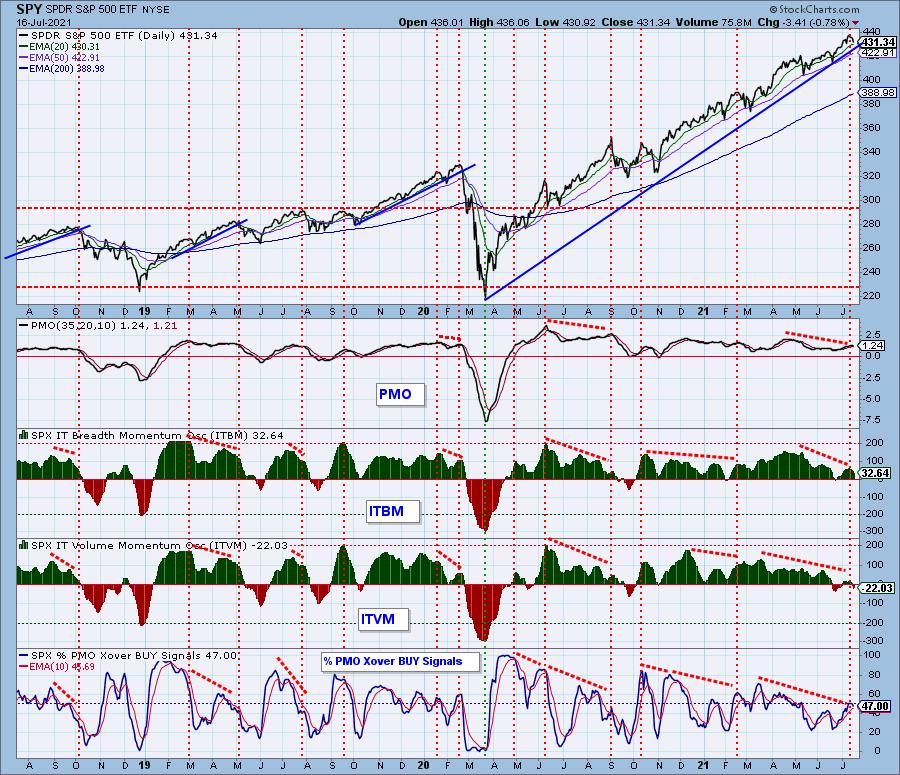
CONCLUSION: Climax analysis helps us determine market direction for the next day or two. Today's selling exhaustion could materialize as an intraday run higher with an end of day decline. More than likely this selling exhaustion will pause the decline, not turn it around. As the market has relentlessly moved to record highs, we can clearly see that the foundation has been steadily crumbling beneath it. This condition could be turned around with renewed buying interest, but at present the internals are very weak and getting worse. If we do see strength, consider it an opportunity to sell. Extreme caution is indicated.
Have you subscribed the DecisionPoint Diamonds yet? DP does the work for you by providing handpicked stocks/ETFs from exclusive DP scans! Add it with a discount! Contact support@decisionpoint.com for more information!
BITCOIN
Bitcoin is slowly meandering toward support at 30,000. While that could be a reversal point, we don't believe it given the ever negative RSI and new PMO SELL signal well-below the zero line.
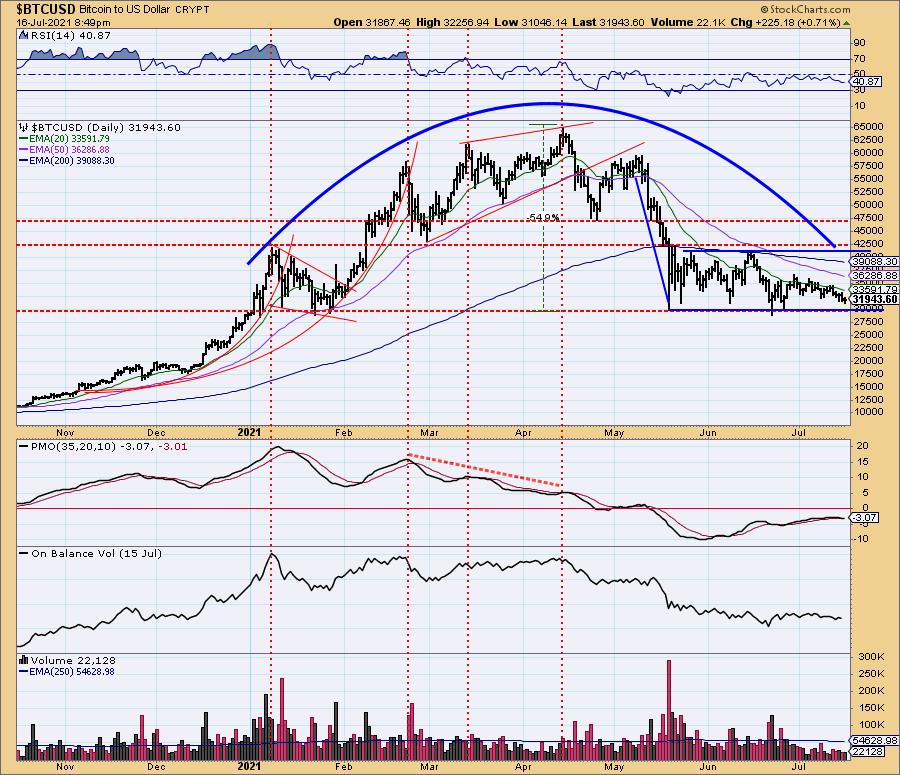
INTEREST RATES
This week yields resumed their declining trends. This is putting the wind at the back of many of the Bond funds.
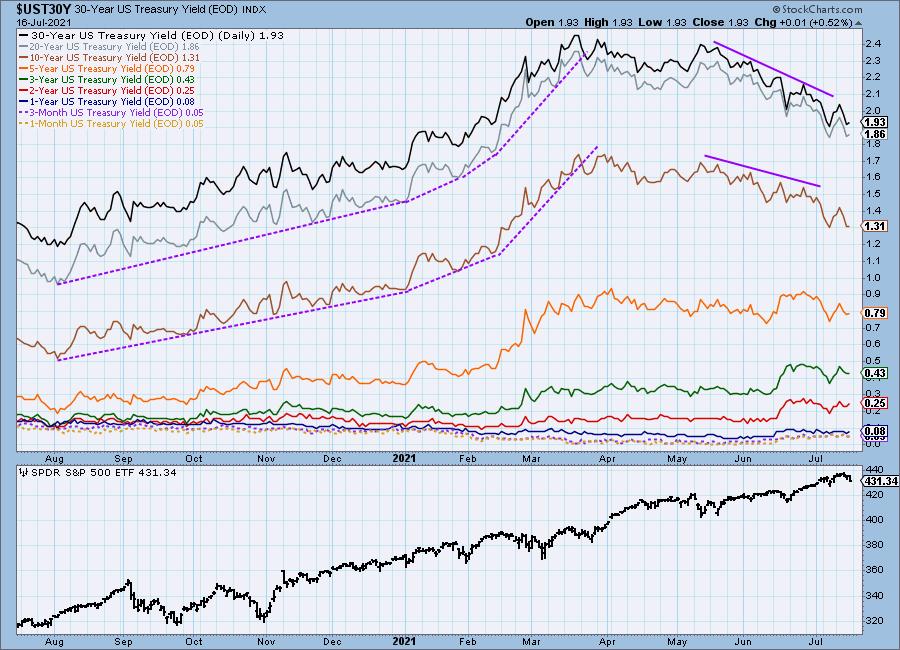
10-YEAR T-BOND YIELD
For now, gap support is holding the 10-year yield up. The declining trend that led to the big decline, is still intact. Resistance has congested at resistance and the 20-EMA. If we do see a rebound, it could create a short-term double-bottom. Until then expect more tests of the gap support between 12 and 12.4.

DOLLAR (UUP)
IT Trend Model: BUY as of 6/22/2021
LT Trend Model: SELL as of 7/10/2020
UUP Daily Chart: UUP ultimately moved higher this week, but it now has overhead resistance to overcome at the July tops. The RSI is positive, but the PMO is being a bit coy, neither rising nor falling.
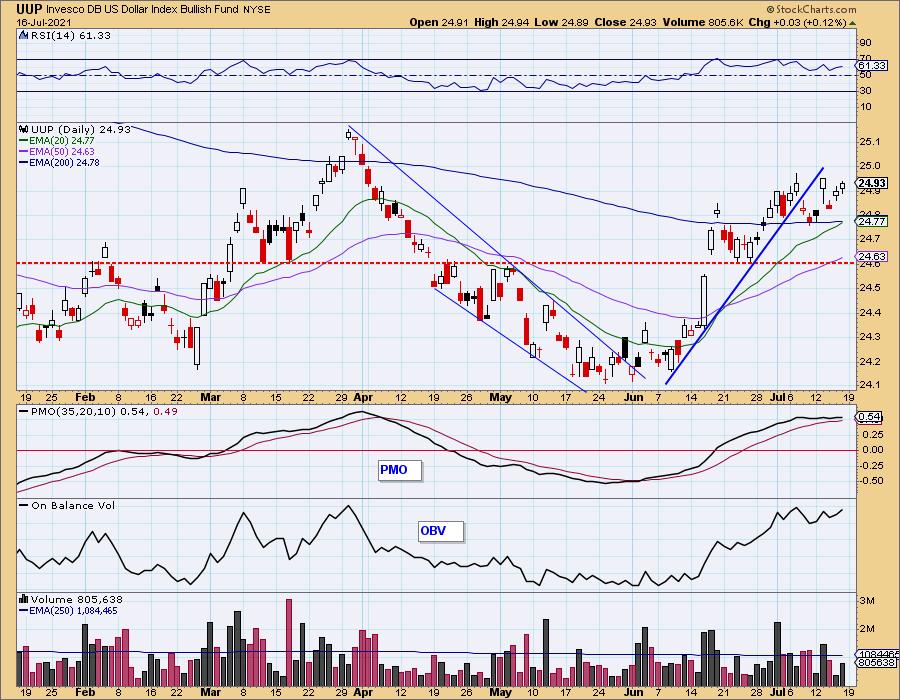
The big picture still suggests a very large bullish double-bottom. Price should at least test resistance at the confirmation line.
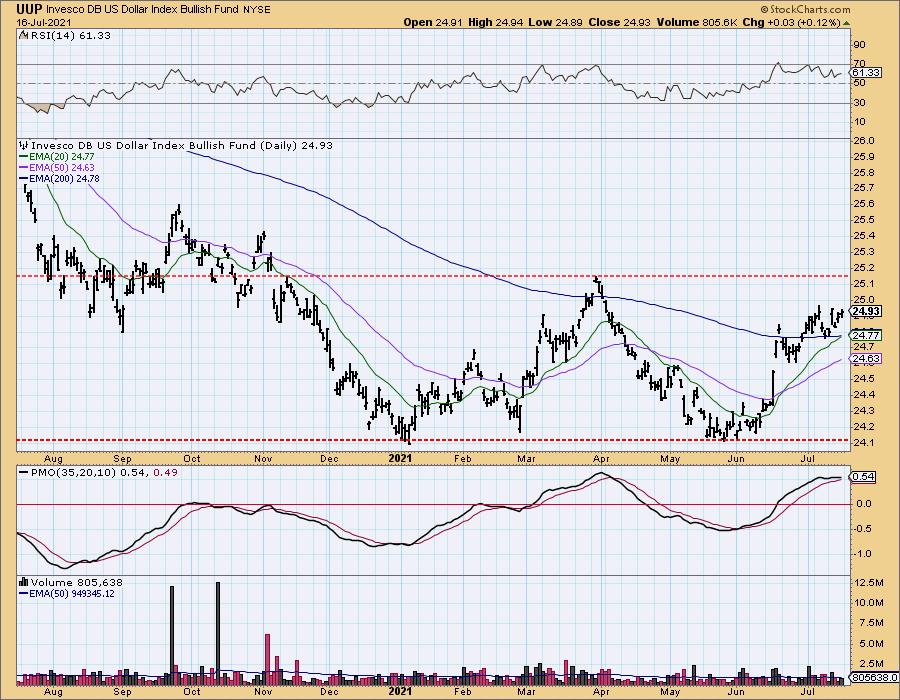
UUP Weekly Chart: The double-bottom is clear on the weekly chart, but price is beginning to weaken. However, given the weekly RSI is positive and the weekly PMO is rising on a BUY signal, as the daily chart suggests, we should get a test of the confirmation line.

GOLD
IT Trend Model: NEUTRAL as of 6/24/2021
LT Trend Model: BUYas of 5/21/2021
GOLD Daily Chart: The bull flag was executed on Wednesday with the strong gap up breakout. However, the picture looks very different today with price pulling back to the 20-EMA. The pattern will bust if price declines further.

The rising RSI and PMO BUY signal suggest Gold will find footing at the 200-EMA. However, on the $Gold chart there is a bearish rising wedge.
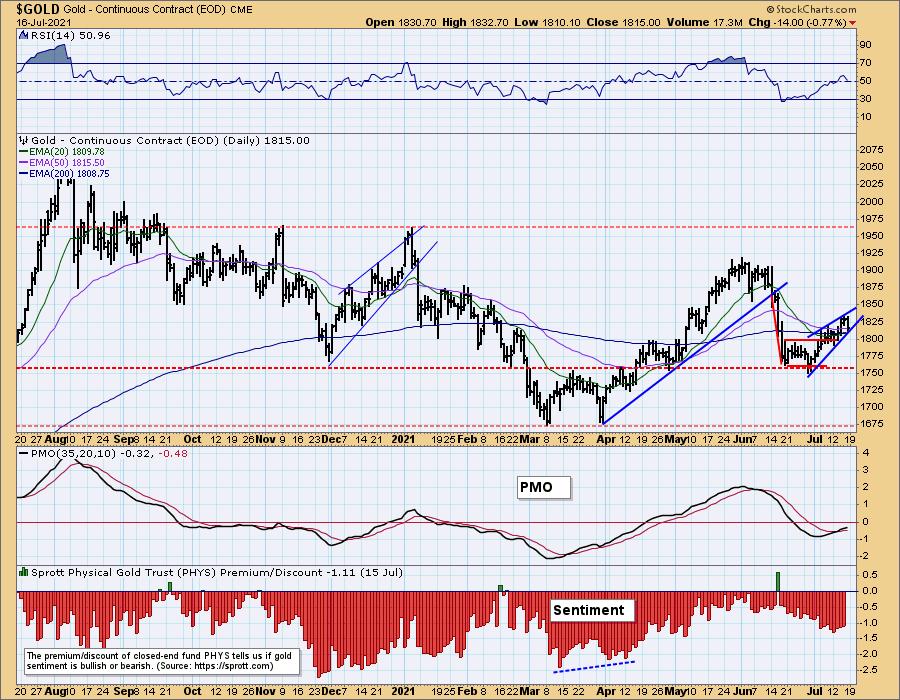
GOLD Weekly Chart: The weekly PMO dropped below its signal line, generating a weekly crossover SELL signal. The weekly RSI is barely positive and while there are discounts, they aren't bearish enough to look for a reversal based on sentiment.
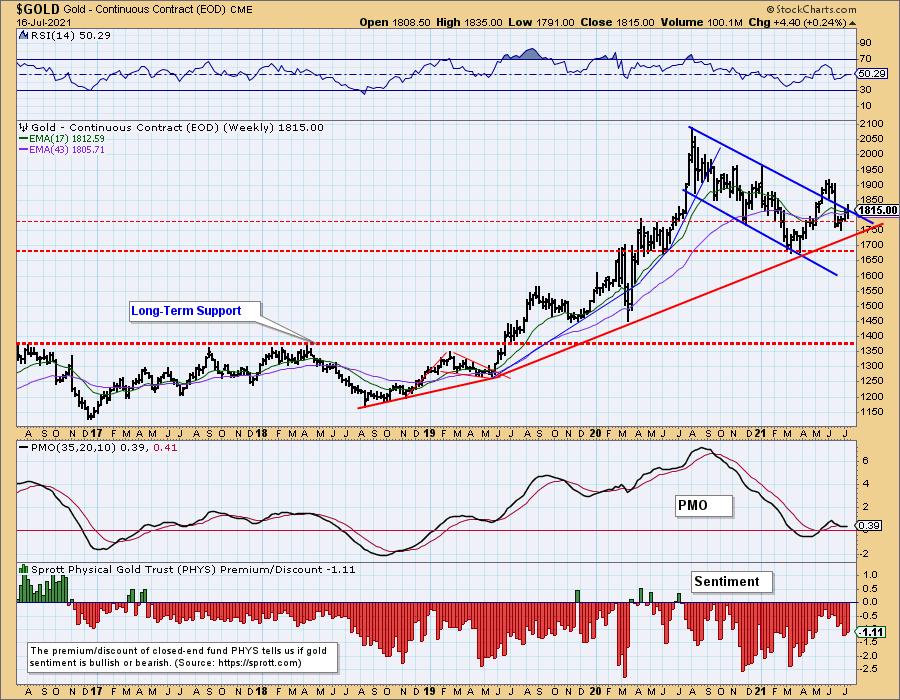
GOLD MINERS Golden and Silver Cross Indexes: Improvement on the Gold Miners chart had us considering entries, but it turns out they weren't ripe given the collapse in participation. Gold's price drop didn't help. Support is still holding, but we have another test of it on tap for next week.

CRUDE OIL (USO)
IT Trend Model: BUY as of 11/23/2020
LT Trend Model: BUY as of 3/9/2021
USO Daily Chart: We now have a bearish double-top in the short term on Crude Oil. While the RSI is barely positive, the PMO continues to decline. Interestingly, minimum downside target of the pattern would take price down to the March high.
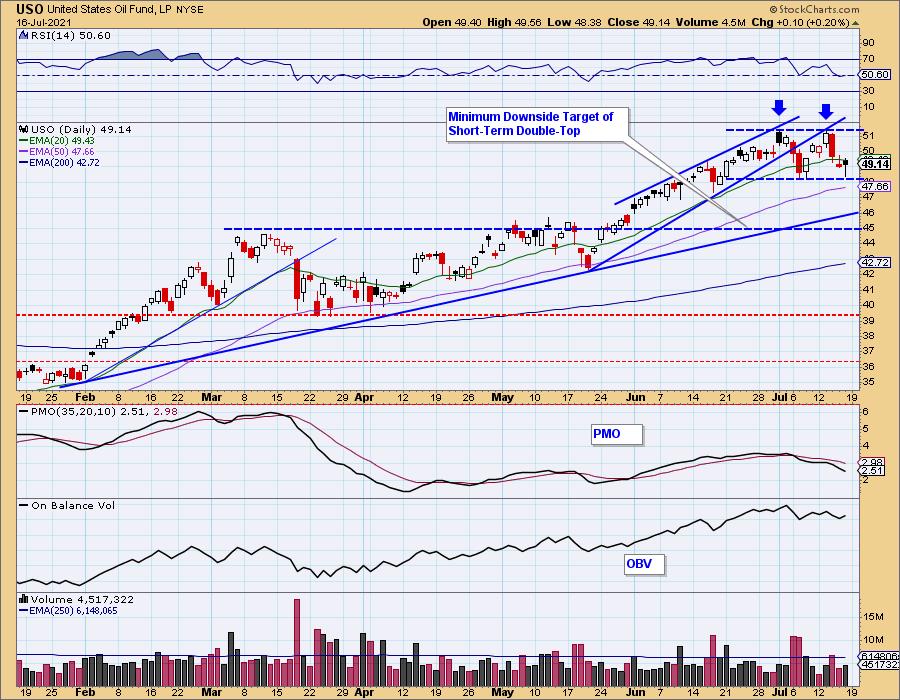
The next test will be the rising bottoms trendline and 50-EMA. If breaks below either of them, look for the downside target of the pattern to be hit.
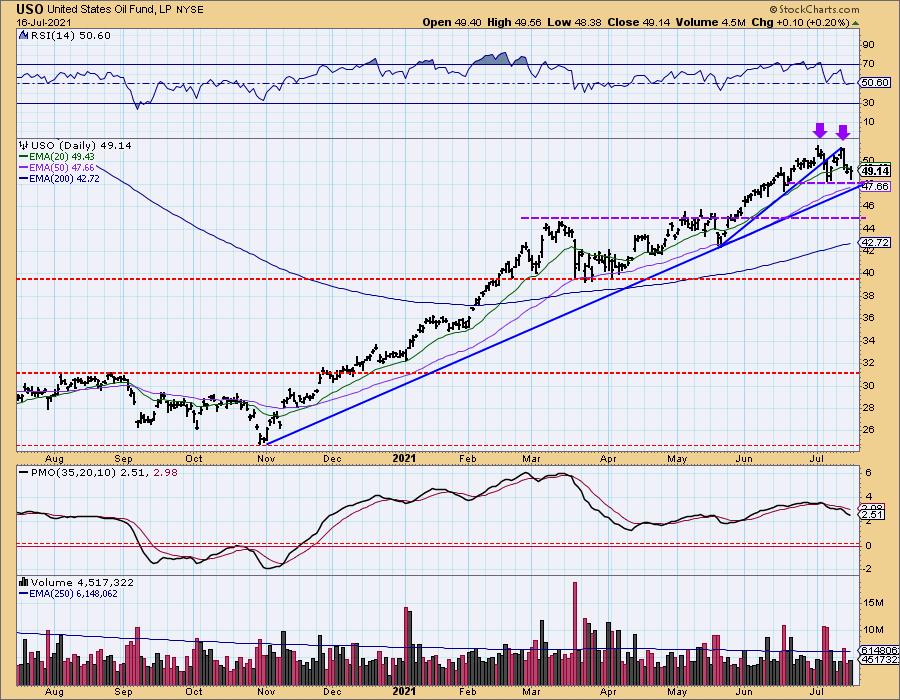
USO/$WTIC Weekly Chart: Notice that $WTIC hit resistance a few weeks ago, this is one of the reasons we are seeing USO struggling against resistance as well. The weekly RSI just left overbought territory, but the weekly PMO has turned down. We should look for lower prices next week.
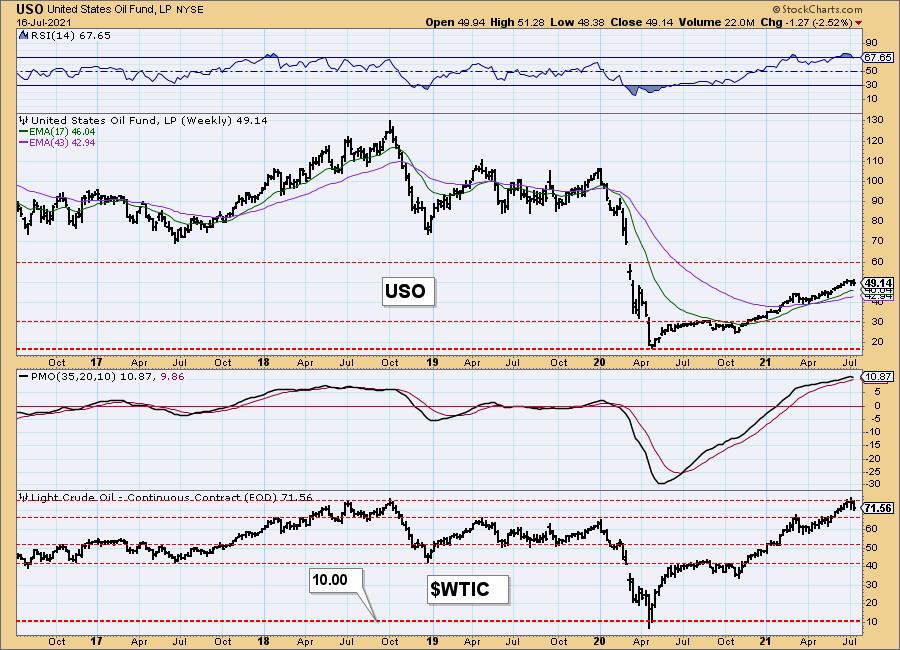
BONDS (TLT)
IT Trend Model: BUY as of 6/10/2021
LT Trend Model: SELL as of 1/8/2021
TLT Daily Chart: Yields declined this week, but TLT still was not able to push past overhead resistance. The RSI and PMO tell us it should find success soon.

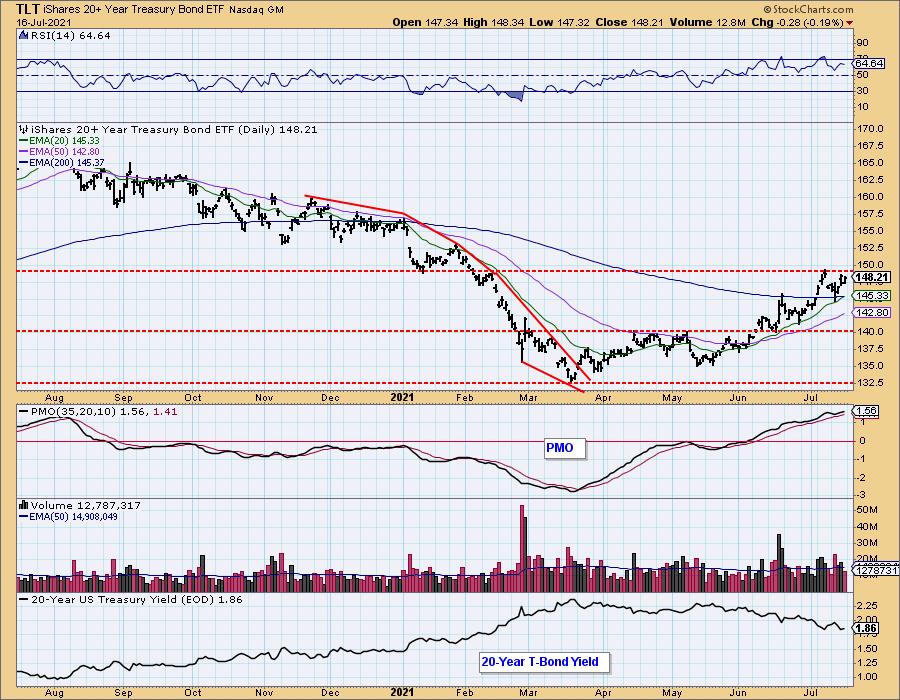
TLT Weekly Chart: The weekly chart shows resistance aligns with the 2nd quarter low. The weekly RSI and PMO look very bullish so price should breakout of this resistance zone soon.
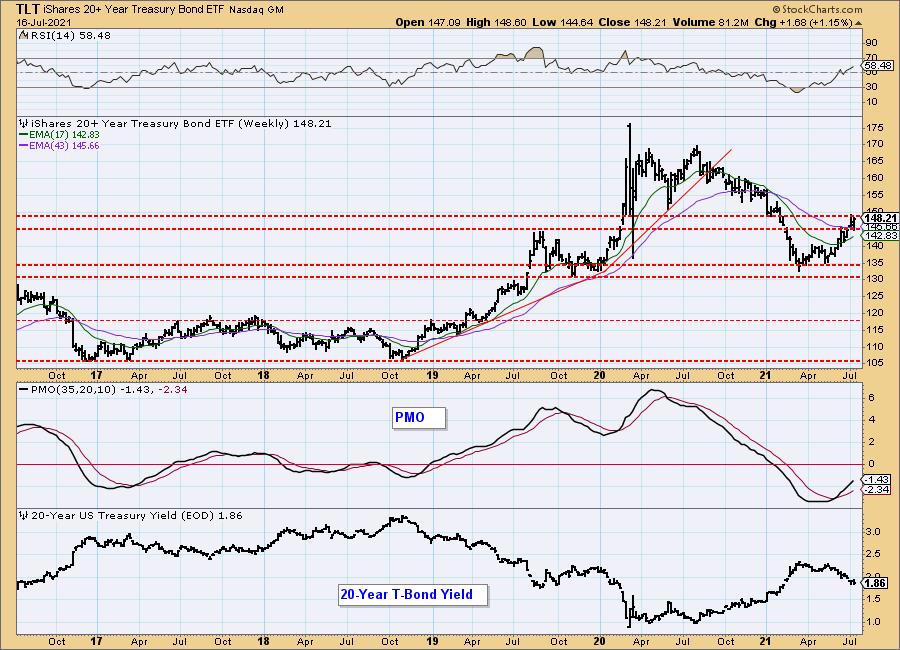
Technical Analysis is a windsock, not a crystal ball.
-- Carl & Erin Swenlin
(c) Copyright 2021 DecisionPoint.com
Disclaimer: This blog is for educational purposes only and should not be construed as financial advice. The ideas and strategies should never be used without first assessing your own personal and financial situation, or without consulting a financial professional. Any opinions expressed herein are solely those of the author, and do not in any way represent the views or opinions of any other person or entity.
NOTE: The signal status reported herein is based upon mechanical trading model signals, specifically, the DecisionPoint Trend Model. They define the implied bias of the price index based upon moving average relationships, but they do not necessarily call for a specific action. They are information flags that should prompt chart review. Further, they do not call for continuous buying or selling during the life of the signal. For example, a BUY signal will probably (but not necessarily) return the best results if action is taken soon after the signal is generated. Additional opportunities for buying may be found as price zigzags higher, but the trader must look for optimum entry points. Conversely, exit points to preserve gains (or minimize losses) may be evident before the model mechanically closes the signal.
Helpful DecisionPoint Links:
DecisionPoint Alert Chart List
DecisionPoint Golden Cross/Silver Cross Index Chart List
DecisionPoint Sector Chart List
Price Momentum Oscillator (PMO)
Swenlin Trading Oscillators (STO-B and STO-V)
DecisionPoint is not a registered investment advisor. Investment and trading decisions are solely your responsibility. DecisionPoint newsletters, blogs or website materials should NOT be interpreted as a recommendation or solicitation to buy or sell any security or to take any specific action.
